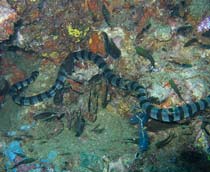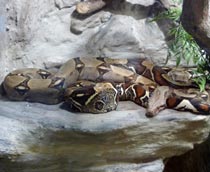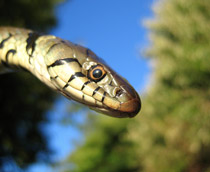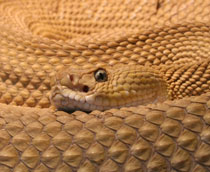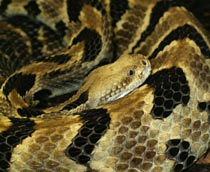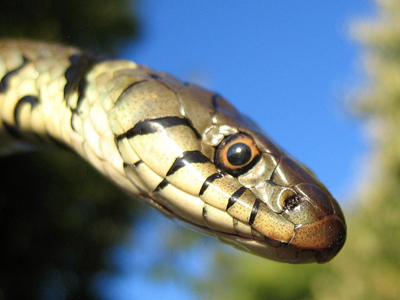
Reptiles and Amphibians - Snakes of the World
Snakes are part of the reptile family. There are many species of snake throughout the world and they inhabit every continent except Antarctica. Not all snakes are venomous. Snakes have no eyelids, they have a transparent scale protecting their eyes. The venom of snakes is a complex mix of proteins that when released into the victim will quickly spread through the body. Neurotoxic venom is the variety that kills the fastest.
Adult venomous snakes will 'ration' the amount of venom they unleash. However baby snakes have not yet learned this and will release a much higher dose, making them potentially more dangerous than their parents! Cobras and Mambas get all the notoriety, but the most toxic snake of all is the Inland Taipan of Australia. It could kill 100 people with a single bite, but thankfully it reserves its wrath for rats.
- Order: Squamata
- Family: Elapidae
- Genus: Naja
- Species: N. naja
- A highly venomous snake and in severe bites can lead to cardiac arrest.
- Well known as the snake of snake charmers.
- The snake is deaf to the charmer's pipe, but uses sight to follow the moving pipe as well as sensing vibrations from the tapping of the charmer's foot.
- Order: Squamata
- Family: Elapidae
- Genus: Naja
- Species: N. haje
- Found in Africa and the Arabian Peninsula.
- Terrestrial and nocturnal in the wild.
- Represented in mythology by the goddess Meretseger.
- Recognisable by its large head and hood.
- Order: Squamata
- Suborder: Serpentes
- Family: Pythonidae
- Genus: Python
- Primarily found in Africa.
- The skin of this snake is used to make a popular Chinese instrument called the Erhu.
- Non-venomous, it crushes its victims with an incredibly muscular body.
- When the heart of the victim stops, the snake will swallow its prey whole.
- It can sometimes take months to digest.
- Usually eats only 4 to 5 times a year.
- Order: Squamata
- Suborder: Serpentes
- Family: Elapidae
- Subfamily: Hydrophiinae
- Inhabits marine environments.
- Huge aggregations of this species have been reported. In 1932 millions were seen from a steamer off the coast of Malaysia. They formed a line of snakes 3 m (9.8 ft) wide and 100 km (62 mi) long!
- Order: Squamata
- Family: Boidae
- Genus: Boa
- Species: B. constrictor
- Non-poisonous, nonetheless just as deadly.
- Use their flicking tongue to pick up a scent.
- Live in tropical environments and are found on the ground and in trees.
- A solitary and nocturnal snake.
- Order: Squamata
- Family: Colubridae
- Genus: Natrix
- Species: N. natrix
- A European non-poisonous snake.
- Found mostly near water.
- Consumes prey live without using constriction.
- To defend themselves, this snake will feign death by becoming totally limp.
- Order: Squamata
- Suborder: Serpentes
- Family: Viperidae
- Has a pair of long hollow fangs with which to give a venomous bite.
- The Adder branch of this species is the only venomous snake found in the UK.
- Its mouth is capable of opening to nearly 180o.
- Generally nocturnal.
- Order: Squamata
- Family: Boidae
- Genus: Eunectes
- Species: E. murinus
- One of the world's largest snakes, with an average length of 6.1 m (20 ft).
- Found in South America.
- Habitat is swamps, marshes and streams.
- Cannibalism has been observed in this species.
- Order: Squamata
- Family: Elapidae
- Genus: Dendroaspis
- Species: D. polylepis
- A notorious African snaker that can reach speeds of up to 20 kmh (12.5 mph).
- Before the advent of an antivenom, a bite from this fearsome serpent was 100 percent fatal, usually within about 20 minutes.
- Order: Squamata
- Suborder: Serpentes
- Family: Viperidae
- Subfamily: Crotalinae
- Even when dead, this snake can still bite if you get too close!
- The snake's heat sensors remain active until rigor mortis is complete, a day or more later.
- Placing a warm object, such as your hand, near the snake's mouth will still cause it to have a go!
Ready for more?
not all...
quizzers. Try to win a coveted spot on our Hall of Fame Page.








